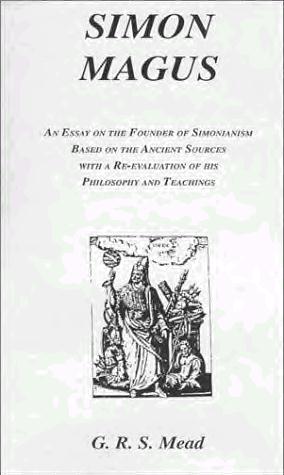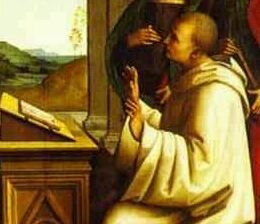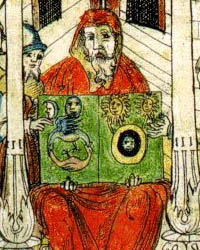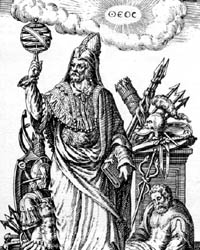|
Christo-Pagan Prayers | Esoteric Mystery School | Christo-Pagan Gods & Goddesses | Heroes, not Saints
Esoteric Saints
Early Church &
Middle Ages Saints
|
New Testament Saints
- James, brother of Yeshua (Gal 1:19)
- Joanna (Luke 8:3 & 24:10)
- Salome (Mark 15:40 & 16:1)
- Susanna (Luke 8:3)
- Junia, female Apostle (Rom 16:7)
- Andronicus, forgotten (Rom 16:7)
- Prisca (“Priscilla,” Rom 16:3, 2 Tim 4:19, Acts 18:26)
- Phoebe, Diakonissa (Romans 16)
|
Old Testament Saints
|

|
Jacques de Molay
1244 to 1314. Last Grand Master of the Knights Templar, Saint and Martyr of Esoteric Christianity. Martyred on March 18th, 1314 for refusing to lie by publicly “confessing” the Knights Templar had committed heresy. He went “down in a blaze of glory” for his beliefs and the honor of his Order. Esoteric Christians and Christo-Pagans remember and revere him to this day. Click on the link above to read about more Saints of our Esoteric Christian church. Here are his legendary last words, as reported by Templar historian, Charles Addison. “To say that which is untrue is a crime both in the sight of God and man. Not one of us has betrayed his God or his country. I do confess my guilt, which consists in having, to my shame and dishonor, suffered myself, through the pain of torture and the fear of death, to give utterance to falsehoods imputing scandalous sins and iniquities to an illustrious Order, which hath nobly served the cause of Christianity. I disdain to seek a wretched and disgraceful existence by engrafting another lie upon the original falsehood.” Unbeknownst to the world, the Pope had pardoned him as a newly re-discovered document in the Vatican archives now proves. Full article available at this link:
London Times OnLine but here is the text.
Were the Templars Pardoned?
Excerpts taken from an article in The Times dated Saturday 30th March 2002, by Richard Owen in Rome
Another document is found after being ‘lost’ for almost 700 years.
Vatican documents have ‘come to light’ showing that the wholesale massacre of the Knights Templar for alleged ‘heresy, idolatry and sexual perversion’, took place even though Pope Clement V had exonerated them in a secret trial. Was this to shift the blame from the Vatican to the court of Phillip IV of France ?
‘The relevation will put pressure on the present Pope, who has asked the Muslim world for forgiveness for the Crusades, to apologise for the persecution of one of the main Crusading Orders as well. The Templars, whose legendary power and wealth still exerts a fascination, were disbanded by Pope Clement V at the Council of Vienne in France in 1312.
L’Avvenire, the Catholic daily, said that the record of the Pope’s investigation was thought to have been lost when Napoleon looted the Vatican during his invasion of Italy in the 18th century, and that its rediscovery was an exceptional event.
The Templar Grand Master, Jacques de Molay, was burnt at the stake on the orders of Phillip IV of France, who coveted the Templar order’s land and treasure and began a campaign of dawn arrests and torture in 1307. At least 2,000 Knights were killed in an attempt to obliterate the order altogether. To this end he failed, as the Knights treasure and their large fleet that lay in the harbour, disappeared before the arrests commenced.
‘The concensus among historians was that Clement V, who was himself French and former Archbishop of Bordeaux, had been pliant and weak, and had colluded in Phillip IV’s scheme to wipe out the Templars and seize their fortune. But documents found in the Vatican archives, including a long-lost parchment, proved that the Pope had in fact maneouvred ‘with skill and determination’ to ensure that his own emissaries questioned de Molay and other leading Templars in the dungeons of Chinon castle in the Loire in 1308, in what amounted to a papal trial.
Signor Frale, who is writing a book based on the Chinon parchment, says that the result was the complete exoneration of the Knights.
Noting that de Molay and the Knights had asked his pardon, the Pope wrote “We hereby decree that they are absolved by the church and may again receive Christian sacraments”. The Pope had failed to make this absolution public because the scandal of the Templars had aroused extreme passions and he feared a church schism. Phillip IV had de Molay and other Templar leaders put to death before the Pope’s verdict could be published and it was subsequently lost.’
|
Top
|
Simon Magus , flourished c. 35 AD
A Gnostic mage with a large following including many of the disciples of John the Baptist.
Blavatsky wrote of Simon Magus describing his abilities and stating that he lived in the 2nd Century AD rather than the time of Yeshua, and was so famous that the Romans erected a statue of him.
Simon Magus was another prominent miracle-worker of the second century, and no one denied his power. Even Christians were forced to admit that he performed miracles. Allusion is made to him in the Acts of the Apostles, viii: 9-10. His fame was world-wide, his followers in every nation, and in Rome a statue was erected in his honor. He had frequent contests with Peter, what we in this day would call miracle-matches in order to determine which had the greater power. It is stated in ‘The Acts of Peter and Paul’ that Simon made a brazen serpent to move, stone statues to laugh, and himself to rise in the air; to which is added: ‘as a set-off to this, Peter healed the sick by a word, caused the blind to see, &c.’ Simon, being brought before Nero, changed his form: suddenly he became a child, then an old man; at other times a young man. ‘And Nero, beholding this, supposed him to be the Son of God.’ “In ‘Recognitions,’ a Petrine work of the early ages, an account is given of a public discussion between Peter and Simon Magus.
|

The booklet above is called, Simon Magus : An Essay on the Founder of
Simonianism Based on the Ancient Sources With a Re-Evaluation of His Philosophy
and Teachings by G. R. S. Mead
|
| Many of the Baptist’s disciples joined Yeshua’s school, but many more stayed with Simon Magus as their leader because Yeshua couldn’t take them all. There is no evidence that Yeshua and Simon ever “fought” over students, and they were probably friends. Simon was later accused of sorcery and heresy by the Church and some rather fantastic tales were made up about him. He is mentioned in Acts Chapter 8. Supposedly he was baptized and even traveled with Philip for a time. The practice of Simony was named after him because he supposedly asked to “buy” the magical tricks of the Apostle Peter and John. One account of the time, however, says it was Paul who tried to buy these “powers” from Yeshua’s direct disciples, not Simon. When the Paulists later reconciled with the rest of the early Christians—when indeed, Paulanity became the central teaching of christianity—Simon Magus’ name was inserted in the story in place of Paul’s. This makes sense because Simon would not have asked for another baptism by one of Yeshua’s disciples when he himself had already been baptized by none other than John the Baptist. Paul never met Yeshua and had to overcome his bad name as a killer of christians and somehow bring legitimacy to the form of christianity he was espousing (inventing?). Paul wanted to be called an Apostle, but the word was reserved for only those who had studied under Yeshua, or at least met him in person. One wonders if the story of his “meeting” Yeshua on the road to Damascus was made up by him to satisfy this requirement. At any rate, many of the early christians sure thought Paul was a fraud, they were called anti-Paulists, and it was a long time before they were wiped out and the church had to find a fall guy for the story in Acts. Simon Magus ticked off certain church “fathers” because his Simonianism was big competition for their new version of christianity, a patriarchal state run church. The Roman’s had loved Simon, even erected a statue of him, but the church “fathers” (more like hijackers) hated anything gnostic and wanted to label anything that was not their idea as heresy.
So Simon got a bad name and new stories were made up about him such as he fell to his death during a flying bout during a battle of the sorcerers between St. Peter and Simon.
To this day fundamentalist christians call Simon the “perfect example of a Satanic believer.” Poor Simon got seriously bad press, but it was all after his death, so hopefully he didn’t mind. It is unclear how he died and there are even theories that two or three Simon Maguses existed, thus the stories of him living in 200 AD as well as at the time of the Apostles.
Here is a good link for more about him:
Biographical
sketch of Simon Magus
Top
Apollonius Tyanaeus
, born 4 BC
Also called Apollonius of Tyana or simply Apollon. This pagan philosopher who lived at the same time as Yeshua, was of noble blood. He studied under a Pythagorean philosopher in Tarsus, oddly enough the birthplace of Paul – though the two are like night and day. Sickened by materialism and pleasure-seeking of his society, he became a cave-dwelling hermit for awhile. Then he went on to a mission of learning, healing, and teaching throughout the world – in Asia Minor, Assyria, Babylonia, Greece, Italy, Spain, Egypt, and India. He had Jain (then called “Gymnosophists”) and possibly Buddhist influences, and was later initiated into the Eleusinian Mysteries. After his death, legends of his miracle-working, prophesying, and charismatic spiritual teachings were recorded. His detailed life story, including some uncanny similarities to Yeshua’s life, was compiled by Flavius Philostratus (lived 170 to 250 AD) at the command of Emperor Severus.
Blavatsky writes of him:
Apollonius Tyaneus was the most remarkable character of that period, and witnessed the reign of a dozen Roman emperors. Before his birth, Proteus, an Egyptian god, appeared to his mother and announced that he was to be incarnated in the coming child. Following the directions given her in a dream, she went to a meadow to gather flowers. While there, a flock of swans formed a chorus around her, and, clapping their wings, sung in unison. While they were thus engaged, and the air was being fanned by a gentle zephyr, Apollonius was born.”
This is a legend which in days of old made of every remarkable character a “son of God” miraculously born of a virgin. And what follows is history. “In his youth he was a marvel of mental power and personal beauty, and found his greatest happiness in conversations with the disciples of Plato, Chrysippus and Aristotle. He ate nothing that had life, lived on fruits and the products of the earth; was an enthusiastic admirer and follower of Pythagoras, and as such maintained silence for five years. Wherever he went he reformed religious worship and performed wonderful acts. At feasts he astonished the guests by causing bread, fruits, vegetables and various dainties to appear at his bidding. Statues became animated with life, and bronze figures ‘ from their pedestals, took the position and performed the labors of servants. By the exercise of the same power dematerializaton occurred; gold and silver vessels, with their contents, disappeared; even the attendants vanished in an instant from sight.
“At Rome, Apollonius was accused of treason. Brought to examination, the accuser came forward, unfolded his roll on which the accusation had been written, and was astounded to find it a perfect blank.
“Meeting a funeral procession he said to the attendants, ‘Set down the bier, and I will dry up the tears you are shedding for the maid.’ He touched the young woman, uttered a few words, and the dead came to life. Being at Smyrna, a plague raged at Ephesus, and he was called thither. ‘The journey must not be delayed,’ he said, and had no sooner spoken the words than he was at Ephesus.
“When nearly one hundred years old, he was brought before the Emperor at Rome, accused of being an enchanter. He was taken to prison. While there he was asked when he would be at liberty? ‘To-morrow, if it depends on the judge; this instant, if it depends on myself.’ Saying this, he drew his leg out of the fetters, and said, ‘You see the liberty I enjoy.’ He then replaced it in the fetters.
“At the tribunal he was asked: ‘Why do men call you a god?’
” ‘Because,’ said he, ‘every man that is good is entitled to the appellation .’
” ‘How could you foretell the plague at Ephesus?’
“He replied: ‘By living on a lighter diet than other men.’
“His answers to these and other questions by his accusers exhibited such strength that the Emperor was much affected, and declared him acquitted of crime; but said he should detain him in order to hold a private conversation. He replied: ‘You can detain my body, but not my soul; and, I will add, not even my body. Having uttered these words he vanished from the tribunal, and that same day met his friends at Puteoli, three days’ journey from Rome.
“The writings of Apollonius show him to have been a man of learning, with a consummate knowledge of human nature, imbued with noble sentiments and the principles of a profound philosophy. In an epistle to Valerius he says:
“‘There is no death of anything except in appearance; and so, also, there is no birth of anything except in appearance. That which passes over from essence into nature seems to be birth, and that which passes over from nature into essence seems, in like manner, to be death; though nothing really is originated, and nothing ever perishes; but only now comes into sight, and now vanishes. It appears by reason of the density of matter, and disappears by reason of the tenuity of essence; but is always the same, differing only in motion and condition.’
“The highest tribute paid to Apollonius was by the Emperor Titus. The philosopher having written to him, soon after his accession, counselling moderation in his government, Titus replied:
” ‘In my own name and in the name of my country I give you thanks, and will be mindful of those things. I have, indeed, taken Jerusalem, but you have captured me.’
“The wonderful things done by Apollonius, thought to be miraculous, the source and producing cause of which Modern Spiritualism clearly reveals, were extensively believed in, in the second century, and hundreds of years subsequent; and by Christians as well as others.
Top
Hypatia of Alexandria
Born: about 370 in Alexandria, Egypt
Died: March 10, 415 A.D. in Alexandria, Egypt
“…she was not only intellectual but also beautiful, eloquent, and
modest.”
Murdered for her brains and beauty. Certain christian monks felt threatened by her and what she represented–the pagan wisdom of the ages as housed in the Library of Alexandria. She was head of the Platonic Academy in Alexandria. March 10 is her feast day in Greece.
“… by her eloquence and authority … attained such influence that
Christianity considered itself threatened … ”
Read about her life, work, books and philosophy at:
Hypatia of Alexandria Biography
Enjoy Wikipedia’s bunch of Hypatia images, info and links.
|

|
Following is an Excerpt from Hypatia
Hypatia was a mathematician, astronomer, and Platonic philosopher. According to the Byzantine encyclopedia The Suda, her father Theon was the last head of the Museum at Alexandria. [And she is said to have been the librarian of the Great Library of Alexandria.]
Hypatia’s prominence was accentuated by the fact that she was both female and pagan in an increasingly Christian environment. Shortly before her death, Cyril was made the Christian bishop of Alexandria, and a conflict arose between Cyril and the prefect Orestes. Orestes was disliked by some Christians and was a friend of Hypatia, and rumors started that Hypatia was to blame for the conflict. In the spring of 415 C.E., the situation reached a tragic conclusion when a band of Christian monks seized Hypatia on the street, beat her, then burned her remains.
“Whatever the precise motivation for the murder, the departure soon afterward
of many scholars marked the beginning of the decline of Alexandria as a major
centre of ancient learning.”
Top
Bernard of Clairveaux

Bernard of Clairveaux was born in 1090 in Fontaines, France, near Dijon. While still young, he was sent to school at Chatillon-sur-Seine, where he developed a taste for literature and poetry, and a devotion for Mary the Blessed Mother. In 1113, he and about 30 of his closest buddies and relatives entered the Cistercian Abbey at Citeaux (currently under the leadership of St. Stephen). Three years later they were sent out to found their own daughter house, in a valley which Bernard named Clairveaux, which in tern spawned several daughter houses within a few years. In 1120, he wrote his first works, ” De Gradibus Superbiae et Humilitatis” and “De Laudibus Mariae”.
align=”Left”> However, among Esoteric Christians, Bernard is best known for his work at the Council of Troyes (1128), wherein Bernard proved to be a major supporter of the Knights Templars, for whom he gave an altered version of the Cistercian rule and presented them with the red cross on white which became their hallmark. Bernard then went on to publicly praise the order in “De Laudibus Novae Militiae”.
Bernard grew to become the one of the most powerful men in Christendom, even seen as more powerful than the Popes he served, as he was seen to have put the Popes on the Throne of Peter himself. However, throughout his career, he never lost his initial devotion to the Blessed Mother, and his theological works never lost their shimmer. Esoteric Christians may be interested by his sermons on the Song of Songs, and his On Loving God.
Top


HermesTrismegistus has a unique name meaning “Thrice Great Hermes.” A true esoteric Christo-Pagan saint, he even has his own feast day, May 24. The Greek word on the cloud in the picture at right says God or Theos. During the Renaissance he was known as the “Gentile Moses,” because his wisdom writings rivalled the books of Moses but were “pagan”. His teachings are a blend of Egyptian, Gnostic and Greek paganism combined with early primitive Kristianity. He is the father of the Hermetic
Tradition and Hermeticism because of his body of writings which are called “body of Hermes” or corpus hermeticum. You’ve heard of the body of Christ, well check out the body of Hermes. Groups like the famous Hermetic Order of the Golden Dawn helped bring his work into modern mystery schools. His earthly name is unknown because it was the custom to sign written works with the godname who inspired them. Therefore he is associated with Hermes (Greek), Mercury (Latin) and Thoth (Egyptian) referred to as the “triple god,” who were all three messenger-gods or message writers (scribes) of the Gods. Read the thirteen lines of his most famous work, the Emerald
Tablet. Many a mage has been assigned the task of memorizing it. The famous line “as above, so below” comes from the Emerald Tablet and is said to pre-date Christianity. Thrice-great Hermes is often pictured holding a book with that line either illustrated with symbols (as pictured left), or written out in Latin, the language of the Renaissance. Check out the hermetic related works and source materials at the Hermetic
Fellowship website.
Top
|
|